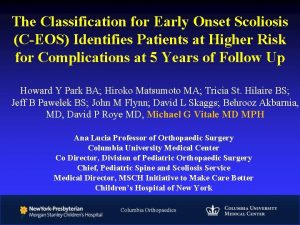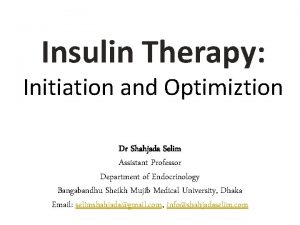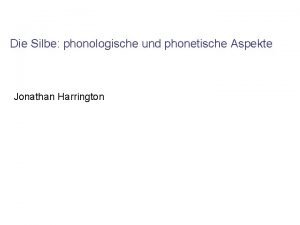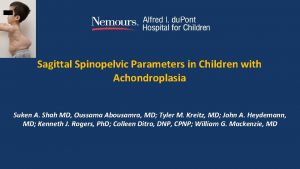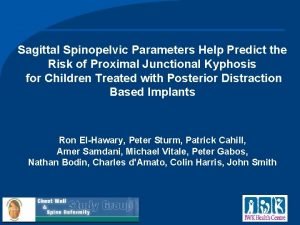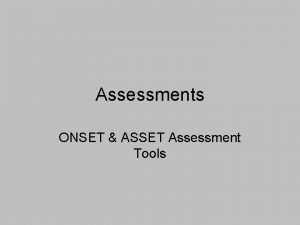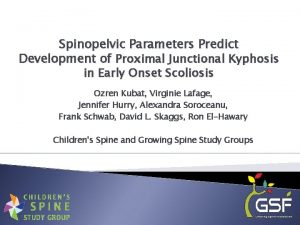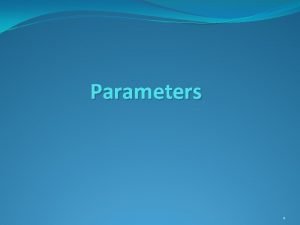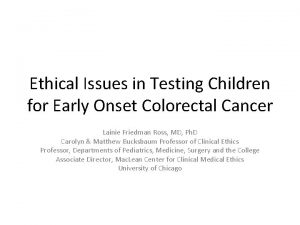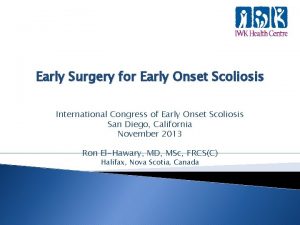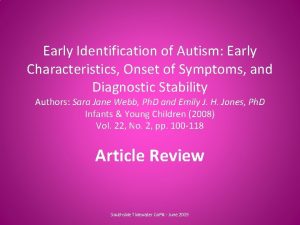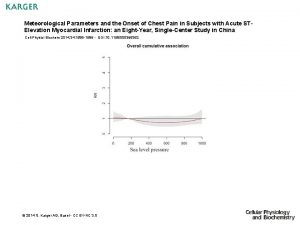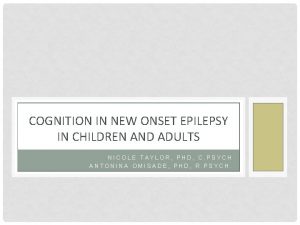Sagittal Spinopelvic Parameters of Children with Early Onset















- Slides: 15

Sagittal Spinopelvic Parameters of Children with Early Onset Scoliosis Ron El-Hawary, Peter Sturm, Jason Howard, Krystyna Cowan Patrick Cahill, Amer Samdani, Michael Vitale, Peter Gabos, Nathan Bodin, Charles d'Amato, Colin Harris, John Smith

Sagittal Spinopelvic Parameters of Children… Presenter: Ron El-Hawary • co-authors: Peter Sturm (a, b) Dupuy Spine, (a) Synthes, (a) Medtronic Amer Samdani Michael Vitale Peter Gabos Nathan Bodin Charles d’Amato (a, b) Depuy Spine, (a) Synthes, (c) Pioneer Surgical (a, b) Depuy Spine, (b) Spine. Guard , (b) Osteotech, (d) Synthes (b) Depuy Spine, (b) Spinevision, (b) Synthes (b) Biomet, (b) Stryker, (a) Medtronic, (e) CWSDSG (b) Depuy Spine no relationships Jason Howard no relationships Krystyna Cowan no relationships Patrick Cahill a. b. c. d. e. Grants/Research Support consultant Stock/shareholder Speakers’ Bureau Other financial support

Spinopelvic Parameters Pelvic incidence Sacral slope Pelvic tilt

Early Onset Scoliosis • Spinopelvic parameters - not defined in children with early onset scoliosis • Important to define because: • May affect natural history • May affect the outcome of surgical intervention

Purpose • To define sagittal plane spinopelvic parameters in a group of children with early onset scoliosis • To define the variability associated with these measurements

Methods • Inclusion • 6 months – 10 years of age (open triradiates) • Scoliosis (ambulatory) • >50 degrees • Exclusion • Previous spine surgery • Non-Ambulatory

Methods • Standing lateral radiographs evaluated • Parameters measured • Thoracic kyphosis, Lumbar lordosis • Pelvic incidence, pelvic tilt, sacral slope, pelvic radius angle • Comparison to age-matched normals • Mac-Thiong et al, Spine 2004

Results • • • N=82 Mean age = 5. 2 years Mean scoliosis = 73. 3 ± 17. 3° Parameters EOS Patients < 10 years old N=82 Mac-Thiong et al. , 2004 Patients < 10 years old (n=35) P Value Sagittal Balance (cm) 2. 4 ± 4. 03 - Thoracic Kyphosis (°) 38. 2 ± 20. 8 38. 3 ± 9. 8 0. 97 Lumbar Lordosis (°) 47. 8 ± 17. 7 45. 6 ± 12. 1 0. 51 Pelvic Incidence (°) 47. 1 ± 15. 6 44. 6 ± 10. 6 0. 48 Pelvic Tilt (°) 10. 3 ± 10. 7 4. 3 ± 8. 1 0. 004 Sacral Slope (°) 35. 5 ± 12. 2 40. 3± 8. 7 0. 06 Modified Pelvic Radius Angle (°) 57. 1 ± 21. 2 -

Results • Mean Sagittal Spine Parameters • Thoracic Kyphosis • Lumbar Lordosis Similar to agematched normals • Mean Sagittal Pelvic Parameters • Pelvic Incidence • Sacral Slope Similar to agematched normals • Pelvic Tilt Significantly higher in EOS patients (p<0. 05)

Results • Intraobserver Variability • Pelvic Incidence 0. 564 • Sacral Slope 0. 947 • Pelvic Tilt 0. 816 • Pelvic Radius Angle 0. 789

Results • Interobserver Variability • Pelvic Incidence NS • Sacral Slope P=0. 003 • Pelvic Tilt NS • Pelvic Radius Angle NS

Conclusions • Sagittal plane spinopelvic parameters have been defined for a group of children with early onset scoliosis • With the exception of increased pelvic tilt, these parameters were found to be similar to those published for children without spinal deformity

Conclusions • Intraobserver and interobserver variability measurements for pelvic tilt and pelvic radius were superior to measurements of pelvic incidence and sacral slope • Measurements of spinopelvic balance may be less variable for pelvic tilt and pelvic radius as they do not rely on orientation of the immature sacral endplate

Conclusions • This data may be useful as a baseline in determining prognosis for children with Early Onset Scoliosis who are treated with growing systems.

Thank You
 Early onset scoliosis classification
Early onset scoliosis classification Early cpr and early defibrillation can: *
Early cpr and early defibrillation can: * Types of insulin chart
Types of insulin chart Anaphylaxis onset
Anaphylaxis onset Onset coda and nucleus
Onset coda and nucleus Voice onset time
Voice onset time Onset and coda examples
Onset and coda examples Marginalization probability
Marginalization probability Silbengewicht
Silbengewicht Onset offset trial
Onset offset trial Lenisierung beispiel
Lenisierung beispiel Labour normal
Labour normal Paprika silben
Paprika silben Webtopings
Webtopings Continuous subcutaneous insulin infusion
Continuous subcutaneous insulin infusion Maximal onset principle example
Maximal onset principle example
